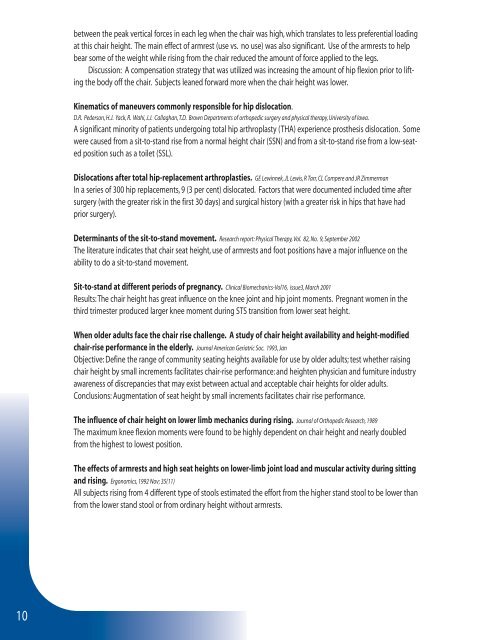Seating Solutions - Rehab Seating Systems, Inc.
Seating Solutions - Rehab Seating Systems, Inc.
Seating Solutions - Rehab Seating Systems, Inc.
You also want an ePaper? Increase the reach of your titles
YUMPU automatically turns print PDFs into web optimized ePapers that Google loves.
10<br />
between the peak vertical forces in each leg when the chair was high, which translates to less preferential loading<br />
at this chair height. The main effect of armrest (use vs. no use) was also significant. Use of the armrests to help<br />
bear some of the weight while rising from the chair reduced the amount of force applied to the legs.<br />
Discussion: A compensation strategy that was utilized was increasing the amount of hip flexion prior to lifting<br />
the body off the chair. Subjects leaned forward more when the chair height was lower.<br />
Kinematics of maneuvers commonly responsible for hip dislocation.<br />
D.R. Pederson, H.J. Yack, R. Wahi, J.J. Callaghan, T.D. Brown Departments of orthopedic surgery and physical therapy, University of Iowa.<br />
A significant minority of patients undergoing total hip arthroplasty (THA) experience prosthesis dislocation. Some<br />
were caused from a sit-to-stand rise from a normal height chair (SSN) and from a sit-to-stand rise from a low-seated<br />
position such as a toilet (SSL).<br />
Dislocations after total hip-replacement arthroplasties. GE Lewinnek, JL Lewis, R Tarr, CL Compere and JR Zimmerman<br />
In a series of 300 hip replacements, 9 (3 per cent) dislocated. Factors that were documented included time after<br />
surgery (with the greater risk in the first 30 days) and surgical history (with a greater risk in hips that have had<br />
prior surgery).<br />
Determinants of the sit-to-stand movement. Research report: Physical Therapy, Vol. 82, No. 9, September 2002<br />
The literature indicates that chair seat height, use of armrests and foot positions have a major influence on the<br />
ability to do a sit-to-stand movement.<br />
Sit-to-stand at different periods of pregnancy. Clinical Biomechanics-Vol16, issue3, March 2001<br />
Results: The chair height has great influence on the knee joint and hip joint moments. Pregnant women in the<br />
third trimester produced larger knee moment during STS transition from lower seat height.<br />
When older adults face the chair rise challenge. A study of chair height availability and height-modified<br />
chair-rise performance in the elderly. Journal American Geriatric Soc. 1993, Jan<br />
Objective: Define the range of community seating heights available for use by older adults; test whether raising<br />
chair height by small increments facilitates chair-rise performance: and heighten physician and furniture industry<br />
awareness of discrepancies that may exist between actual and acceptable chair heights for older adults.<br />
Conclusions: Augmentation of seat height by small increments facilitates chair rise performance.<br />
The influence of chair height on lower limb mechanics during rising. Journal of Orthopedic Research, 1989<br />
The maximum knee flexion moments were found to be highly dependent on chair height and nearly doubled<br />
from the highest to lowest position.<br />
The effects of armrests and high seat heights on lower-limb joint load and muscular activity during sitting<br />
and rising. Ergonomics, 1992 Nov; 35(11)<br />
All subjects rising from 4 different type of stools estimated the effort from the higher stand stool to be lower than<br />
from the lower stand stool or from ordinary height without armrests.


